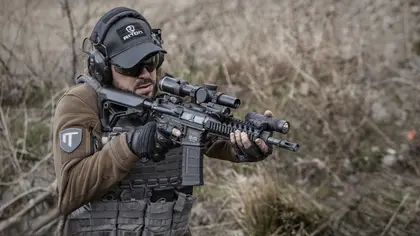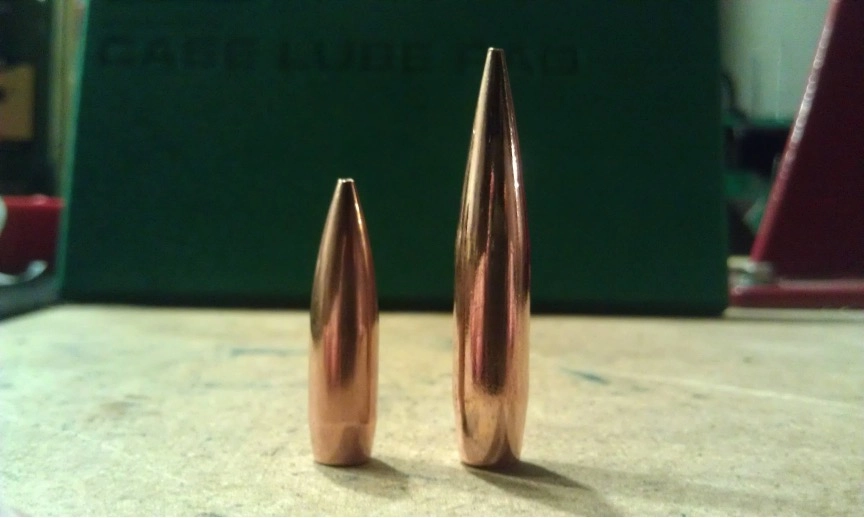A French rifle tapped to be handed over to the Ukrainian military for sniper work as part of a $36 million Paris-Kyiv arms deal is inferior to weapons already in use by Armed Forces of Ukraine (AFU) shooter teams, Ukrainian, American and British combat veterans and arms experts told Kyiv Post in a series of interviews.
At issue is a rifle called a VCD10, a semi-automatic weapon manufactured by a small French company specializing in high-grade hunting weapons called Verney-Carron. Per the terms of a Nov. 8 agreement between the St. Etienne firm and the Ukrainian state arms import-export company Ukrspetseksport, Verney-Carron will be paid from a French military assistance fund for Ukraine to manufacture 2,000 of the rifles for AFU sniper teams.
A boutique manufacturer of high-end civilian market hunting rifles and shotguns, Verney-Carron may face problems scaling up production to meet the substantial Ukrainian order, which also includes 10,000 battle rifles and 400 grenade launchers. A previous Kyiv Post article covered those possible gearing up and quality control issues.
Interviews with veteran snipers and weapons experts pointed to a more basic problem with the sniper rifle France plans to buy for Ukrainian shooters: Even if produced to the highest standards, and delivered on deadline, the French precision rifles Ukrspetseksport has contracted for are, they said, not very suitable for combat conditions in Ukraine.

Diane Francis Interviews Mikhail Zygar, Yaroslav Trofimov on Prospects of Russia’s War on Ukraine
Kyiv Post interviewed three in-service Ukrainian snipers, each with more than a year of combat experience, a former US combat arms officer with combat experience and trained as a small arms maintainer, a former British army sniper with frontline combat experience in Ukraine, and a retired British special operations team member currently assisting Ukrainian frontline units.
Ukrspetseksport, Verney-Carron, and the Verney-Carron parent company Cybergun had not responded to Kyiv Post requests for comment by the time this article was published.
Lebel, the French company marketing the VCD10, describes the rifle as a precision-shooting weapon firing the NATO standard .308 caliber round [.308 Win. (Winchester) in civilian form]. That cartridge, also known as 7.62x51mm NATO in mil spec form, is a tested rifle round first developed by the US in the early 1950s.
The VCD10’s action – the mechanism that reloads a rifle after a round is fired – is semi-automatic, meaning every time a shooter presses the trigger, the rifle shoots and then reloads the next cartridge into the chamber automatically so it is ready for a quick follow-on shot.
Accuracy – typically out to 600-800 meters – was engineered into the weapon largely thanks to a long barrel, making the weapon almost twice as accurate as battle rifles of the day.
During the Cold War, the Soviet Union and its allies manufactured hundreds of thousands of their own 7.62x54mmR semi-automatic, long-barreled rifles as part of a strategy to field marksmen in every infantry platoon.
A useful side-benefit for Soviet logistic officers was that the SVD sniper rifle used the same rimmed cartridge as their standard medium machine guns, such as the belt-fed PKM [not to be confused with the 7.62x39mm rimless cartridge used in the AK-47 assault/battle rifle].
The VDC10, likewise, uses the same 7.62x51mm NATO cartridge for the Alliance’s standard medium machine guns, such as the belt-fed M60.
But NATO armies and other modern militaries approached sniping differently from the Soviet Union, choosing to arm fewer but more highly trained shooters not with semi-automatic sniper rifles but more accurate bolt-action rifles.
A bolt action mechanism forces a shooter to work a handle on the rifle to load a new round, after each time the weapon is fired. Although slower firing, a bolt action according to most marksmen is more accurate than a semi-automatic action because a bolt action design is easier to equip with a heavier and more precise barrel, is less likely to jam, and according to most (but not all) shooters makes a shooter more accurate. Additionally, bolt actions are less likely to jam or have other malfunctions, and if equipped with a claw extractor can remove damaged or deformed casings.
Lebel describes the VCD10, inspired by the US-made Armalite AR-10 tactical assault/battle rifle, and effectively a modern French version of the Cold War-era SVD-style rifles, as “the ideal partner for the precision shooter in any environment.” The promotional video shows slow-motion images of a sunglass-wearing shooter firing the rifle from a kneeling position.
In the eight years of war leading up to Russia’s second invasion of Ukraine, effectively, Ukrainian snipers have come to use home-grown tactics and marksmanship drills close to and frequently identical with NATO best practices, and rifles out of sync with the weapon specs and battlefield marketing produced by Verney-Carron.
The Ukrainian army in 2014 during Russia’s first invasion fielded semi-automatic Soviet-era SVD rifles, but central government supply and training of snipers was poor. Civilian volunteers, marksmanship enthusiasts, hunters and reform-minded soldiers stepped in to fill the gap.
By the late 2010s Ukrainian snipers deployed to fight Russian infantry and Russia-sponsored “volunteers” along the Donbas line of contact had largely evolved to tactics and equipment built around small, highly practiced, teams armed with bolt-action rifles equipped with heavy barrels, and carrying ammunition in calibers designed and loaded specifically for sniping.
The Soviet-era SVD and semi-automatic rifles like it was, by 2020-21, excepting national guard and territorial defense units, no longer used by Ukrainian snipers. The Verney-Carron VCD10 “sniper” rifle [actually a tactical assault/battle rifle] would, like the Soviet-era SVD, be too inaccurate for Ukrainian snipers in combat to use effectively at common battlefield ranges, and if issued would probably be left on base rather than being taken along on a mission, the three Ukrainian army snipers interviewed for this article agreed.
Both Ukrainian and NATO nation military shooters pointed to the French rifle’s use of the NATO-standard 7.62x51mm/.308 Win. caliber cartridge, a bog-standard ammunition type most commonly used in medium-caliber machine guns across the alliance, as a major shortcoming.
Like any other flying object, a NATO-standard 7.62mm bullet will veer off target increasingly as ranges open. In the shooting community, the measurement for that natural deviation is called a “minute of angle” (MOA), meaning 1/60th of a degree. For the NATO-standard 7.62mm cartridge fired by the VDC 10 (and hundreds of other rifles and machine guns), the deviation is known: about 2.5 cm. every hundred meters. This means that, assuming a quality build, a 7.62mm VCD10 rifle would, based on its MOA, reliably hit a 20 cm.-wide target at 400 m., and a 40 cm.-wide target – at 800 m.
The basic problem, veteran shooters said, is that one MOA isn’t suitable for sniping in the actual Russo-Ukraine war, with shots often taken at about 1 km.
“If I am going to shoot, I need a weapon that will put a bullet into a 10 cm. circle at 1,000 meters, every single time. Even the best sniper in the world can’t do that with a basic .30 ammunition,” AFU sniper Volodymyr “Bond” Petrenko told Kyiv Post in an August interview. “The enemy is hiding. The targets we see are small and fleeting – part of a head, a shoulder, something like that. If I take an SVD rifle (firing a 7.62x54mmR caliber bullet) even if I get a clean shot it’s going to be almost impossible to get a hit, because the bullet won’t fly accurately enough to where I’m aiming.”
Mike Riedmuller, a retired US Army reconnaissance officer trained in weapons maintenance, and a combat veteran, questioned whether the barrel fitted to the French sniper rifle, available from the manufacturer in 16 inch (41 cm), 18 inch (46 cm) and 20 inch (51 cm) lengths, was right for battlefield shooting conditions faced by AFU snipers.
“The VCD10 barrel is too short…The shorter barrels they (Verney-Carron) knock a lot of velocity off of a 7.62mm round,” Riedmuller said.
Typical civilian target shooting bolt action rifles, such as the Remington 700, Winchester 70, and others chambered in .308 Win. usually have 24 inch (61 cm) heavy barrels.
Shooters said a sniper rifle in the Russo-Ukraine war should best be chambered to use a cartridge firing a bullet heavier than the standard 7.62mm cartridge. The heavier weight bullets of larger caliber rounds can help mitigate the effect of wind over long distances and reduce the deceleration (and loss of energy) of the projectile over the extended time from muzzle exit to the target range.
Several (but not all) named a cartridge/caliber called the .338 Lapua Magnum (.338 LM), a bullet heavier in weight and physically bigger than the NATO .308 caliber bullet fired by the Verney-Carron VCD10, as the best ammunition for the job. Cartridges like the .338 Lapua Magnum are big and heavy so a soldier can’t carry nearly as many of them, but that really isn’t a shortcoming for snipers, they said.
Typical bullet weights for a .308/7.62mm range from 147 to 175 grains (9.5 to 11.3 g), while the standard .338 bullet weighs 250 grains (16.2 g), or 40-70 percent heavier.
Shane Matthews, a former British Army Sniper with Ukraine war combat experience, said of the VCD10 for sniping on the Ukrainian battlefield: “There are far better calibers available that would increase the accurate range with minimal training involved, for example, the .338, which has an accurate engagement range of 1,800m and a flatter trajectory at a longer distance.”
According to open sources, the inherent accuracy of the .338 round, due to its heavier weight and more powerful powder charge, is almost exactly half the deviation at range of a .308 round, especially when fired from a more stable, heavier barrel through bolt action loading system less vulnerable to fouling were taken into account.
Interviewees said a sniper on a Ukrainian battlefield armed with an AI rifle chambered for .338 LM cartridges would expect to reliably hit targets in the 800-1000m range envelope, while the same shooter armed with a VCD10 would consider a hit at that range a lucky accident. A British special operations veteran told Kyiv Post an intentional hit with a .308 bullet in battlefield conditions at ranges above 800 meters would be “a small miracle”.
A British sniper rifle competing on the civilian market directly with the VCD10, the Accuracy International (AI) AXMC, is offered in three calibers including the popular-with-AFU-snipers .338 Lapua Magnum caliber. The list price of that weapon is $4,700.
Matthews said of the VCD10: “The cost is also an issue as there are plenty of weapons available on the open market, that again, cost less and perform better ballistically.”
Kyiv Post was unable to find evidence of the VCD10 in use with any military anywhere, nor of the rifle’s availability on European civilian markets aside from individual orders in the $3,500-$4,000 price range.
According to a 2018 interview with General Director Guillaume Verney-Carron, the company developed the rifle to compete, unsuccessfully as it turned out, in a Europe-wide tender to manufacture sniper rifles for multiple EU nation armies. The mandated caliber for the design was 7.62mm/.308, he said.
NATO-standard 7.62mm bullet (L) shown in a comparison image with a .338 Lapua Magnum bullet (R). Ukrainian and major western military snipers prefer a heavier sniper rifle round because it is more accurate at long rangers. Per the terms of a Nov. 8 arms deal between the Ukrainian government and the French arms company Verney-Carron, Ukrainian army snipers will get rifles firing the smaller, less-capable bullet.
You can also highlight the text and press Ctrl + Enter







